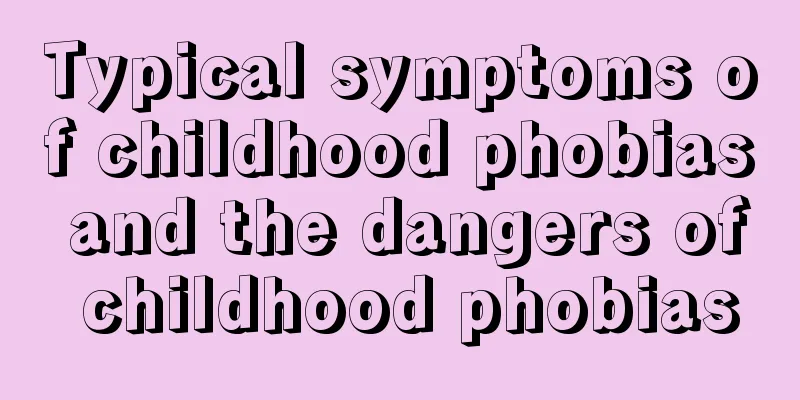Typical symptoms of childhood phobias and the dangers of childhood phobias

|
Childhood phobia refers to a strong and unwilling fear of the external environment or things that children show. Many parents think that their children are introverted and timid and often ignore this disease. Typical symptoms of phobias in children1. Some children often have low self-esteem and are not very confident in life. They are afraid of the surrounding environment and will lock themselves in a dark corner. They are unwilling to communicate with others and are even less willing to let people around them show concern for them. If people around them pay attention to them, they will also have a rebellious mentality. 2. Unwilling to communicate with strangers. Children will feel particularly scared when they meet strangers, and will not actively communicate or talk with such people. If they are in a dimly lit environment, children will show fear and always need to be accompanied by adults. If parents find that their children have such behavior, they should help them overcome it as soon as possible and let them contact strangers and unfamiliar environments more often. 3. Very sensitive to the external environment. Some children will only immerse themselves in their own world and are unwilling to communicate with others. They lack social skills and are very sensitive to the external environment. When children go out with their families, they always lower their heads. When they meet strangers, they are unwilling to communicate with them, especially familiar friends, and they will not take the initiative to say hello. The dangers of childhood phobias1. Childhood phobia can affect a child's personality. The psychological shadow of early childhood may affect a child's life, such as being ridiculed as a child and not daring to speak in public when growing up. 2. It may cause autism in children. Surveys have shown that children's phobia is an important factor causing autism in children. 3. It will cause character defects in children, make their growth process very difficult, and may even lead some children to go on the wrong path. 4. Children are prone to anxiety or obsessive-compulsive disorder. Things to note about children's phobiasChildren's phobia has a great impact on children's health and psychology, so parents should try not to spoil their children and give them more opportunities to exercise their courage. Spoiling children will only make them timid, dependent, and lacking in self-confidence. In addition, parents should also be careful not to be capricious with their children. They should educate their children in a standardized and consistent manner to avoid their children being at a loss. They should also not lose their temper with their children or blame them too much, which will make them overly afraid of their parents, reduce their self-confidence, and even aggravate their fear. Treatment for childhood phobias1. Cognitive therapy. The emergence of fear is often caused by a lack of cognition of certain things, so first of all, we must build up the child’s confidence in treatment, let the child recognize the nature of fear, delve into the root of the patient’s "fear", understand the patient’s fear level of certain things, and then correct some of the patient’s ideas, so that the patient can correctly evaluate his position in the environment and have a comprehensive understanding of the disease. 2 Skill training There are many types of phobias, and the most common one is social phobia. This type of patient has certain deficiencies in social skills, which can be improved through social skills training, self-affirmation, self-improvement, social reinforcement, etc. If it is agoraphobia, you need to exercise your coping ability more, but when exercising, you need more support from family and friends to avoid some overreactions. 3. Exposure therapy Exposure therapy is commonly used in psychotherapy and is very effective in treating phobias. It is to put the patient directly in front of the feared thing. For example, patients with claustrophobia can be placed in a small dark room, and patients with social phobia can be placed in a crowd, so that they can face their fear. However, this therapy often needs to be combined with psychotherapy. If it is not handled properly, it will be counterproductive. In particular, some patients will have extreme behaviors after receiving fear stimulation, and even faint due to excessive fear. Therefore, treatment needs to be carried out under the guidance of a doctor. |
<<: How should mothers teach their daughters to be good role models?
>>: How to deal with stone milk? Do not apply hot compress to stone milk
Recommend
Which country's brand is Dettol? Is Dettol disinfectant safe?
Everyone should be familiar with the brand of Det...
Why can't babies with eczema be vaccinated? Why should babies with eczema be moisturized?
Babies need to be vaccinated after birth, and the...
Is a spoonful of baby milk powder a flat spoon or a full spoon? How many grams does a spoonful of baby milk powder weigh?
When preparing milk powder for babies, there are ...
Why are babies particularly sensitive? Four characteristics of highly sensitive children
The issue of skin sensitivity has always been a f...
How can parents help their children go through puberty smoothly?
Adolescence is really an awkward period, wanderin...
How to deal with baby's earwax that becomes hard lumps? Here are 3 ways to deal with it
It is easy for earwax to grow in the ears, which ...
The most ruthless weight loss strategy after childbirth: do this to lose weight!
Many postpartum mothers are worried: Why can'...
How does baby dandruff occur? How to remove baby dandruff?
We often see that newborn babies have a lot of da...
What does a chest X-ray mainly check? How long after a chest X-ray can men and women have children?
Chest X-ray mainly uses X-rays to see if there ar...
What are the misunderstandings about feeding babies? 5 major misunderstandings to pay attention to
Many parents will continue to feed their children...
What are the good foods for children to eat to lose weight? What are the good foods for children to eat to lose weight?
Babies are the treasures of the family. They need...
What is the reason for children's soft nails? What should I do if my child's nails are soft?
There is a discipline in traditional Chinese medi...
Can I eat smashed cucumbers during confinement? Can I eat raw cucumbers during confinement?
Summer is here and the editor finds that cucumber...
Can pregnant women use Australian papaya cream? Can pregnant women use Australian papaya cream?
Australian papaya cream is a brand from Australia...
Can pregnant women eat dragon fruit in the early stages of pregnancy? What are the taboos for pregnant women to eat fruit?
There are many things that pregnant women need to...









